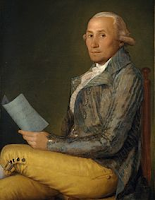LECTURE is about a particular phase in Francisco Goya's life that led to his prolific manifestation of etchings and aquatint caricatures.
We will look at - Los Caprichos & Los Disparates
* analyse the different themes of these cartoon etchings linking allegorical criticism with aesthetic pessimism
* technique and composition of the plates
INTRODUCTION
At this time Goya travelled to Cádiz in Andalusia with Sebastián Martínez y Pérez (1747 - 1800), an enlightened Spanish politician and merchant who was also known as a collector of books, engravings and paintings.
Los Caprichos (The Whims or The Caprices) illustrate a world in crisis. Conceptually, they reveal the cracks of a socio-political structure based on stagnant class stratification and a value system founded on the immobility of mores and the tyrannical religious suppression of conscience.
Los Caprichos, published in 1799, was his first foray into this new direction. Satirical prints had existed before him, but never before had anyone ventured such a sharp and uncompromising critique of social mores and hypocrisy.
The eighty plates, measuring about 12 1/2 x 8 3/4 inches, were published in book form at the moderate price of 320 reales in a shop opposite Goya's own house in Madrid's "Calle del Desengano" (Street of Disillusionment). Unsurprisingly, despite Goya's careful and often ambiguous captions, it was not popular in certain circles, and he was forced to stop selling it after only 23 copies were bought.
In 1803, Goya was harassed by the political right and persecuted by the Inquisition. He was eventually rescued by King Carlos IV who liked Goya personally and was probably too obtuse to realise that he had portrayed him as a bumbling idiot. The King ordered that all unsold sets and the original copper plates be handed over to the Crown and publicly declared that Goya had acted on his instructions, saving him from the Inquisitors.
Los Disparates (The Follies), also known as Proverbios (Proverbs) or Sueños (Dreams), is a series of prints in etching and aquatint, with retouching in drypoint and engraving, created by Goya between 1815 and 1823. He created the series while living in his house near Manzanares (Quinta del Sordo), on whose walls he painted the famous Black Paintings. When he moved to Bordeaux in 1824, he left these works unfinished. During Goya's lifetime, the series was not published due to the repressive political climate and the Inquisition. The series was first published by the Royal Academy of Fine Arts of San Fernando in 1864.
The plates of the Disparates are rich in dreamlike visions, violence and sex, mockery of the institutions of the old regime and general criticism of established power. The prints combine a diverse fantasy world related to the night, the carnival and the grotesque, which is both print by print and an enigma in its entirety.
*******APPRECIATE ART & CULTURE * LOVE SPAIN
Resource Books written by
Karla Ingleton Darocas
and published by
SpainLifestyle.com
Resource Books written by
Karla Ingleton Darocas
and published by
SpainLifestyle.com
* CLICK HERE *





